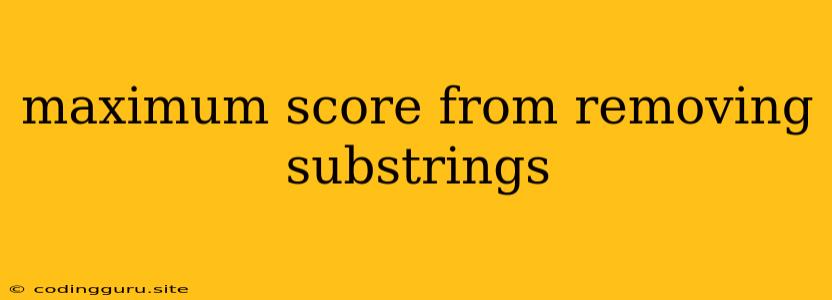Maximizing Your Score: A Deep Dive into Substring Removal
In the world of computer science, string manipulation is a fundamental task. From analyzing DNA sequences to processing natural language, understanding how to work with strings is crucial. One intriguing problem that arises in this domain involves maximizing the score obtained by strategically removing substrings from a given string.
Imagine you are presented with a string and a set of rules dictating how points are awarded for removing specific substrings. Your objective is to determine the highest possible score you can achieve by meticulously removing substrings from the initial string, adhering to the given rules.
Understanding the Challenge
Let's break down the essence of this problem:
- The Input: You are given a string, representing the initial sequence of characters.
- The Rules: A set of substrings and their associated point values are defined. Each substring represents a pattern that, when removed from the original string, yields a specific score.
- The Goal: Find the optimal sequence of substring removals that maximizes the total score achieved.
Tackling the Challenge: Strategies for Optimization
This problem presents a fascinating challenge, requiring us to devise a strategy for identifying the most advantageous removals. Here are some approaches to consider:
1. Greedy Approach
A natural starting point is to employ a greedy strategy. This involves repeatedly removing the substring with the highest point value at each step, hoping to maximize the score in a step-by-step manner.
Example:
Let's say our input string is "ABAB" and we have the following substrings with their scores:
- "AB": 3 points
- "BA": 2 points
A greedy approach might first remove "AB," leading to a score of 3 points and the string "AB." Next, it would remove "AB" again, resulting in a final score of 6 points.
While this approach can be effective, it's important to note that it might not always lead to the optimal solution. There might be cases where removing a seemingly "less valuable" substring early on could open up opportunities for more profitable removals later.
2. Dynamic Programming
For more complex scenarios, dynamic programming emerges as a powerful tool. This technique involves breaking down the problem into smaller, overlapping subproblems and storing their solutions to avoid redundant computations.
Illustrative Example
Consider the input string "AACAA" and the following substrings with their scores:
- "AA": 5 points
- "AC": 2 points
Here's how dynamic programming can be applied:
-
Subproblem Definition: We define a subproblem as finding the maximum score achievable by removing substrings from a substring of the initial string, starting at a specific index.
-
Base Case: The base case is when the substring has length 0. In this case, the maximum score is 0.
-
Recursive Relation: For a substring starting at index
i, we consider two possibilities:- Remove the substring ending at
i: If the substring starting atimatches a substring in our rules, we calculate the score achieved by removing it and add it to the maximum score achievable by removing substrings from the remaining substring. - Do not remove the substring ending at
i: We simply move to the next character (i + 1) and recursively calculate the maximum score achievable from that point.
- Remove the substring ending at
-
Tabulation: We store the solutions to the subproblems in a table, allowing us to reuse them efficiently.
3. Backtracking
Backtracking is another technique that can be employed. This approach involves exploring all possible combinations of substring removals, systematically building up a solution. It prunes branches of the search tree when it encounters a configuration that cannot lead to a higher score.
Example
Let's say our string is "ABC" and we have the following substrings:
- "AB": 2 points
- "BC": 3 points
Backtracking would explore the following scenarios:
- Remove "AB": This leads to a score of 2 points and the string "C."
- Remove "BC": This leads to a score of 3 points and the string "A."
It would then analyze the resulting substrings ("C" and "A") and determine the optimal sequence of removals based on the scores obtained.
Choosing the Right Approach
The optimal approach will depend on the specific problem instance. Greedy algorithms can be a good starting point for smaller problems, but for more complex cases with numerous substrings and potentially overlapping patterns, dynamic programming or backtracking might be more suitable.
The Significance of "Maximum Score from Removing Substrings"
The problem of maximizing the score from removing substrings is not just a theoretical exercise. It has applications in various domains, including:
- Text Editing: Optimizing text formatting by removing unnecessary spaces or repetitive patterns.
- Bioinformatics: Analyzing DNA sequences by identifying and removing specific motifs or sequences that might indicate genetic mutations.
- Natural Language Processing: Processing text data by identifying and removing stop words or other irrelevant substrings.
Conclusion
The "maximum score from removing substrings" problem presents a fascinating challenge in string manipulation, prompting us to explore various algorithmic approaches for optimization. Whether employing greedy strategies, dynamic programming, or backtracking, the key lies in carefully analyzing the input string, the scoring rules, and the dependencies between substring removals to achieve the highest possible score. As we continue to explore this problem and its applications, we gain valuable insights into the power of string manipulation and its impact across diverse fields.
